Advent
Advent is a season of the liturgical year observed in many Christian churches as a time of expectant waiting and preparation for both the celebration of the Nativity of Jesus at Christmas and the return of Jesus at the Second Coming. Advent is the beginning of the Western liturgical year. The term "Advent" is also used in Eastern Orthodoxy for the 40-day Nativity Fast, which has practices different from those in the West.[3]
| Advent | |
|---|---|
An acolyte lighting Advent candles | |
| Observed by | Christians |
| Type | Christian, cultural |
| Significance | Preparation for the commemoration of the birth of Jesus |
| Observances | Church services, completing an Advent calendar and Advent wreath,[1] praying through a daily devotional,[1] erecting a Chrismon tree,[1] hanging of the greens,[1] lighting a Christingle,[2] gift giving, family and other social gatherings |
| Begins | Fourth or (in the Ambrosian and Mozarabic Rites) sixth Sunday before Christmas |
| 2019 date | 1 December |
| 2020 date | 29 November |
| 2021 date | 28 November |
| 2022 date | 27 November |
| Frequency | Annual |
| Related to | Christmastide, Christmas Eve, Annunciation, Epiphany, Epiphanytide, Baptism of the Lord, Nativity Fast, Nativity of Jesus |
The term adopted from Latin adventus "coming; arrival", translating Greek parousia. In the New Testament, this is the term used for the Second Coming of Christ. Thus, the season of Advent in the Christian calendar anticipates the "coming of Christ" from three different perspectives: the physical nativity in Bethlehem, the reception of Christ in the heart of the believer, and the eschatological Second Coming.[4]
In the Roman Rite of the Catholic Church, the Western Rite of the Orthodox Church, and in the Anglican, Lutheran, Moravian, Presbyterian, and Methodist calendars, Advent commences on the fourth Sunday before Christmas—the Sunday nearest to St. Andrew's Day (30 November). It can fall on any date between 27 November and 3 December. When Christmas Day is a Monday, Advent Sunday will fall on its latest possible date.[5] In the Ambrosian Rite and the Mozarabic Rite of the Catholic Church, Advent begins on the sixth Sunday before Christmas, the Sunday after St. Martin's Day (11 November).[6]
Practices associated with Advent include keeping an Advent calendar, lighting an Advent wreath, praying an Advent daily devotional,[1] erecting a Christmas tree or a Chrismon tree,[1] lighting a Christingle,[2] as well as other ways of preparing for Christmas, such as setting up Christmas decorations,[7][8][9] a custom that is sometimes done liturgically through a hanging of the greens ceremony.[1][10] The equivalent of Advent in Eastern Christianity is called the Nativity Fast, but it differs in length and observances, and does not begin the liturgical church year as it does in the West. The Eastern Nativity Fast does not use the equivalent parousia in its preparatory services.[11]
History
It is not known when the period of preparation for Christmas that is now called Advent began – it was certainly in existence from about 480 – and the novelty introduced by the Council of Tours of 567 was to order monks to fast every day in the month of December until Christmas.[12] It is "impossible to claim with confidence a credible explanation of the origin of Advent".[13]
Associated with Advent was a period of fasting, known also as the Nativity Fast or the Fast of December.[14]
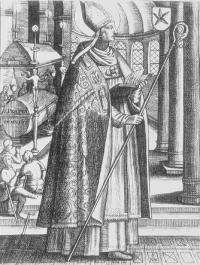
According to Saint Gregory of Tours the celebration of Advent began in the fifth century when the Bishop Perpetuus directed that starting with the feast of St. Martin, 11 November, until Christmas, one fasts three times per week; this is why Advent is also named Lent of St. Martin. This practice remained limited to the diocese of Tours until the sixth century.[15]
But the Macon council held in 581 adopted the practice in Tours and soon all France observed three days of fasting a week from the feast of Saint Martin until Christmas. The most devout worshipers in some countries exceeded the requirements adopted by the Council of Macon, and fasted every day of Advent. The homilies of Gregory the Great in the late sixth century showed four weeks to the liturgical season of Advent, but without the observance of a fast.[16] However, under Charlemagne in the ninth century, writings claim that the fast was still widely observed.
In the thirteenth century, the fast of Advent was not commonly practised although, according to Durand of Mende, fasting was still generally observed. As quoted in the bull of canonisation of St. Louis, the zeal with which he observed this fast was no longer a custom observed by Christians of great piety. It was then limited to the period from Saint Andrew until Christmas Day, since the solemnity of this apostle was more universal than that of St. Martin. When Pope Urban V ascended the papal seat in 1362, he simply forced people in his court to abstinence but there was no question of fasting. It was then customary in Rome to observe five weeks of Advent before Christmas. This is particularly discussed in the Sacramentary of St. Gregory. Ambrosian or Milan Liturgies have six. The Greeks show no more real consistency; Advent was an optional fast that some begin on 15 November, while others begin on 6 December or only a few days before Christmas.[17]
The liturgy of Advent remained unchanged until the Second Vatican Council, in 1963, introduced minor changes, differentiating the spirit of Lent from that of Advent, emphasising Advent as a season of hope for Christ's coming now as a promise of his Second Coming.[18]
Traditions
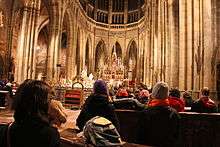
| Christian liturgical year |
|---|
| Western |
| Eastern |
|
| East Syriac Rite |
|
The theme of readings and teachings during Advent is often the preparation for the Second Coming, while also commemorating the First Coming of Christ at Christmas. The first clear references in the Western Church to Advent occur in the Gelasian Sacramentary, which provides Advent Collects, Epistles, and Gospels for the five Sundays preceding Christmas and for the corresponding Wednesdays and Fridays.[19] While the Sunday readings relate to the first coming of Jesus Christ as saviour as well as to his Second Coming as judge, traditions vary in the relative importance of penitence and expectation during the weeks in Advent.
Liturgical colours
Since approximately the 13th century, the usual liturgical colour in Western Christianity for Advent has been violet; Pope Innocent III declared black to be the proper colour for Advent, though Durandus of Saint-Pourçain claims violet has preference over black.[20] The violet or purple colour is often used for hangings around the church, the vestments of the clergy, and often also the tabernacle. In some Christian denominations, blue, a colour representing hope, is an alternative liturgical colour for Advent, a custom traced to the usage of the Church of Sweden (Lutheran) and the medieval Sarum Rite in England. In addition, the colour blue is also used in the Mozarabic Rite (Catholic and Anglican), which dates from the 8th century. This colour is often referred to as "Sarum blue".
The Lutheran Book of Worship lists blue as the preferred colour for Advent while the Methodist Book of Worship and the Presbyterian Book of Common Worship identify purple or blue as appropriate for Advent. There has been an increasing trend in Protestant churches to supplant purple with blue during Advent as it is a hopeful season of preparation that anticipates both Bethlehem and the consummation of history in the Second Coming of Jesus Christ.[21]
Proponents of this new liturgical trend argue that purple is traditionally associated with solemnity and somberness, which is fitting to the repentant character of Lent. The Roman Catholic Church retains the traditional violet.[22] Blue is not generally used in Latin Catholicism,[23] and where it does regionally, it has nothing to do with Advent specifically, but with veneration of the Blessed Virgin.[24] However, on some occasions that are heavily associated with Advent, such as the Rorate Mass (but not on Sundays), white is used.[25]
On the third Sunday of Advent, Gaudete Sunday, rose may be used instead, referencing the rose used on Laetare Sunday, the fourth Sunday of Lent.[26] A rose coloured candle in Western Christianity is referenced as a sign of joy (Gaudete) lit on the third Sunday of Advent.[27]
During the Nativity Fast, red is used by Eastern Christianity, although gold is an alternative colour.[28]
Music
_2010-07-14_290.jpg)
Many churches also hold special musical events, such as Nine Lessons and Carols and singing of Handel's Messiah oratorio. Also, the Advent Prose, an antiphonal plainsong, may be sung. The "Late Advent Weekdays", 17–24 December, mark the singing of the Great Advent 'O antiphons'.[29] These are the daily antiphons for the Magnificat at Vespers, or Evening Prayer (in the Roman Catholic and Lutheran churches) and Evensong in Anglican churches, and mark the forthcoming birth of the Messiah. They form the basis for each verse of the popular Advent hymn, "O come, O come, Emmanuel". German songs for Advent include "Es kommt ein Schiff, geladen" from the 15th century and "O Heiland, reiß die Himmel auf", published in 1622. Johann Sebastian Bach composed several cantatas for Advent in Weimar, from Nun komm, der Heiden Heiland, BWV 61, to Herz und Mund und Tat und Leben, BWV 147a, but only one more in Leipzig where he worked for the longest time, because there Advent was a silent time which allowed cantata music only on the first of the four Sundays.
During Advent, the Gloria of the Mass is omitted, so that the return of the angels' song at Christmas has an effect of novelty.[30] Mass compositions written especially for Lent, such as Michael Haydn's Missa tempore Quadragesimae, in D minor for choir and organ, have no Gloria and so are appropriate for use in Advent.
Fasting
Bishop Perpetuus of Tours, who died in 490, ordered fasting three days a week from the day after Saint Martin's Day (11 November). In the 6th century, local councils enjoined fasting on all days except Saturdays and Sundays from Saint Martin's Day to Epiphany (the feast of baptism), a period of 56 days, but of 40 days fasting, like the fast of Lent. It was therefore called Quadragesima Sancti Martini (Saint Martin's Lent).[6] This period of fasting was later shortened and called "Advent" by the Church.[31]
In the Anglican and Lutheran churches this fasting rule was later relaxed. The Roman Catholic Church later abolished the precept of fasting (at an unknown date at the latest in 1917), later, but kept Advent as a season of penitence. In addition to fasting, dancing and similar festivities were forbidden in these traditions. On Rose Sunday, relaxation of the fast was permitted. Eastern Orthodox and Oriental Orthodox churches still hold the tradition of fasting for 40 days before Christmas.
Local rites
In England, especially in the northern counties, there was a custom (now extinct) for poor women to carry around the "Advent images", two dolls dressed to represent Jesus and the Blessed Virgin Mary. A halfpenny coin was expected from every one to whom these were exhibited and bad luck was thought to menace the household not visited by the doll-bearers before Christmas Eve at the latest.[32]
In Normandy, farmers employed children under twelve to run through the fields and orchards armed with torches, setting fire to bundles of straw, and thus it was believed driving out such vermin as were likely to damage the crops.[33]
In Italy, among other Advent celebrations is the entry into Rome in the last days of Advent of the Calabrian pifferari, or bagpipe players, who play before the shrines of Mary, the mother of Jesus: in Italian tradition, the shepherds played these pipes when they came to the manger at Bethlehem to pay homage to the infant Jesus.[34]
In recent times the most common observance of Advent outside church circles has been the keeping of an advent calendar or advent candle, with one door being opened in the calendar, or one section of the candle being burned, on each day in December leading up to Christmas Eve. In many countries, the first day of Advent often heralds the start of the Christmas season, with many people opting to erect their Christmas trees and Christmas decorations on or immediately before Advent Sunday.[9]
Since 2011, an Advent labyrinth consisting of 2500 tealights has been formed for the third Saturday of Advent in Frankfurt-Bornheim.[35][36]
Advent wreath
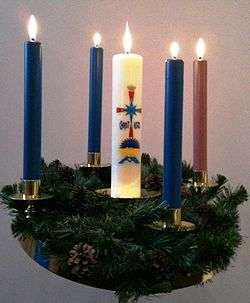
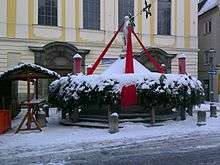
The concept of the Advent wreath originated among German Lutherans in the 16th Century.[37] However, it was not until three centuries later that the modern Advent wreath took shape.[38] The modern Advent wreath, with its candles representing the Sundays of Advent, originated from an 1839 initiative by Johann Hinrich Wichern, a Protestant pastor in Germany and a pioneer in urban mission work among the poor. In view of the impatience of the children he taught as they awaited Christmas, he made a ring of wood, with nineteen small red tapers and four large white candles. Every morning a small candle was lit, and every Sunday a large candle. Custom has retained only the large candles.[39]
The wreath crown is traditionally made of fir tree branches knotted with a red ribbon and decorated with pine cones, holly, laurel, and sometimes mistletoe. It is also an ancient symbol signifying several things; first of all, the crown symbolises victory, in addition to its round form evoking the sun and its return each year. The number four represents, in addition to the four weeks of Advent, the four seasons and the four cardinal virtues, and the green colour is a sign of life and hope. The fir tree is a symbol of strength and laurel a symbol of victory over sin and suffering. The latter two, with the holly, do not lose their leaves, and thus represent the eternity of God. The flames of candles are the representation of the Christmas light approaching and bringing hope and peace, as well as the symbol of the struggle against darkness. For Christians, this crown is also the symbol of Christ the King, the holly recalling the crown of thorns resting on the head of Christ.
The keeping of an Advent wreath is a common practice in homes or churches. The Advent wreath is traditionally placed on a table with four candles or, without candles, on the front door of the house as a welcome sign.[40]
The Advent wreath is adorned with candles, usually three violet or purple and one pink, the pink candle being lit on the Third Sunday of Advent, called Gaudete Sunday after the opening word, Gaudete, meaning "Rejoice", of the entrance antiphon at Mass. Some add a fifth candle (white), known as the Christ Candle, in the middle of the wreath, to be lit on Christmas Eve or Day.[41]
The candles added to the wreath crown symbolise, in one interpretation, the great stages of salvation before the coming of the Messiah; the first is the symbol of the forgiveness granted to Adam and Eve, the second is the symbol of the faith of Abraham and of the patriarchs who believe in the gift of the Promised Land, the third is the symbol of the joy of David whose lineage does not stop and also testifies to his covenant with God, and the fourth and last candle is the symbol of the teaching of the prophets who announce a reign of justice and peace. Or they symbolise the four stages of human history; creation, the Incarnation, the redemption of sins, and the Last Judgment.[42]
In Orthodox churches there are sometimes wreaths with six candles, in line with the six-week duration of the Nativity Fast/Advent.
In Sweden, white candles, symbol of festivity and purity, are used in celebrating Saint Lucy's Day, 13 December, which always falls within Advent.
Four Sundays
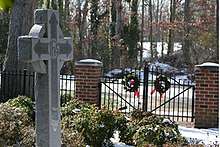

In the Roman Rite of the Catholic Church, the readings of Mass on the Sundays of Advent have distinct themes:[41]
- On the First Sunday (Advent Sunday), they look forward to the Second Coming of Christ.
- On the Second Sunday, the Gospel reading recalls the preaching of John the Baptist, who came to "prepare the way of the Lord"; the other readings have associated themes.
- On the Third Sunday (Gaudete Sunday), the Gospel reading is again about John the Baptist, the other readings about the joy associated with the coming of the Saviour.
- On the Fourth Sunday, the Gospel reading is about the events involving Mary and Joseph that led directly to the birth of Jesus, while the other readings are related to these.
- The readings for the first Sunday in Advent relate to the Old Testament patriarchs who were Christ's ancestors, so some call the first Advent candle that of hope.
- The readings for the second Sunday concern Christ's birth in a manger and other prophecies, so the candle may be called that of Bethlehem, the way, or of the prophets.
- The third Sunday, Gaudete Sunday after the first word of the introit (Philippians 4:4), is celebrated with rose-coloured vestments similar to Laetare Sunday at the middle point of Lent. The readings relate to John the Baptist, and the rose candle may be called that of joy or of the shepherds. In the Episcopal Church USA, the collect "Stir up" (the first words of the collect) may be read during this week, although before the 1979 revision of the Book of Common Prayer it was sometimes read in the first Sunday of Advent. Even earlier, 'Stir-up Sunday' was once jocularly associated with the stirring of the Christmas mincemeat, begun before Advent. The phrase "stir up" occurs at the start of the collect for the last Sunday before Advent in the 1662 Book of Common Prayer.[45]
- The readings for the fourth Sunday relate to the annunciation of Christ's birth, so the candle may be known as the Angel's candle. The Magnificat or Song of Mary may be featured.
- Where an Advent wreath includes a fifth candle, it is known as the Christ candle and is lit during the Christmas Eve service.
Other variations of the themes celebrated on each of the four Sundays include:
- The Prophets' Candle, symbolizing hope; the Bethlehem Candle, symbolizing faith; the Shepherds' Candle, symbolizing joy; the Angel's Candle, symbolizing peace[41]
- Hope–Peace–Joy–Love[46]
- Faithfulness–Hope–Joy–Love[47]
- Prophets–Angels–Shepherds–Magi[47]
- Faith–Prepare–Joy–Love[48]
See also
- Christmas market
- Dormition Fast
- Ember days
- Fasting and abstinence in the Roman Catholic Church
- Great Lent
- Mortification of the flesh in Christianity
- Nativity Fast
References
- Kennedy, Rodney Wallace; Hatch, Derek C (27 August 2013). Baptists at Work in Worship. Wipf and Stock Publishers. p. 147. ISBN 978-1-62189-843-6.
There are a variety or worship practices that enable a congregation to celebrate Advent: lighting an advent wreath, a hanging of the greens service, a Chrismon tree, and an Advent devotional booklet.
- Geddes, Gordon; Griffiths, Jane (2001). Christianity. Heinemann. p. 99. ISBN 978-0-435-30695-3.
Many churches hold Christingle services during Advent. Children are given a Christingle.adaa
- perspective., Articles on moral / morality from Orthodox Christian. "Fr. Patrick Henry Reardon -- The Origins of Advent". orthodoxytoday.org. Retrieved 15 November 2017.
- "since the time of Bernard of Clairvaux (d.1153), Christians have spoken of the three comings of Christ: in the flesh in Bethlehem, in our hearts daily, and in glory at the end of time" Pfatteicher, Philip H. (23 September 2013). "Journey into the Heart of God: Living the Liturgical Year". Oxford University Press – via Google Books.
- Company, Our Sunday Visitor Catholic Publishing. "Our Sunday Visitor Catholic Publishing Company > My Faith > Church Seasons and Feasts > Advent". osv.com. Retrieved 15 November 2017.
- Philip H. Pfatteicher, Journey into the Heart of God (Oxford University Press) 2013 ISBN 978-0-19999714-5
- The Lutheran Witness. 80. Concordia Publishing House. 1961.
- Michelin (10 October 2012). Germany Green Guide Michelin 2012–2013. Michelin. p. 73. ISBN 9782067182110.
Advent – The four weeks before Christmas are celebrated by counting down the days with an advent calendar, hanging up Christmas decorations and lightning an additional candle every Sunday on the four-candle advent wreath.
- Normark, Helena (1997). Modern Christmas. Graphic Garden.
Christmas in Sweden starts with Advent, which is the await for the arrival of Jesus. The symbol for it is the Advent candlestick with four candles in it, and we light one more candle for each of the four Sundays before Christmas. Most people start putting up the Christmas decorations on the first of Advent.
- Rice, Howard L.; Huffstutler, James C. (1 January 2001). Reformed Worship. Westminster John Knox Press. p. 197. ISBN 978-0-664-50147-1.
Another popular activity is the "Hanging of the Greens," a service in which the sanctuary is decorated for Christmas.
- "Four Reasons It's Not 'Advent.'". Kevin (Basil) Fritts. Retrieved 29 September 2014.
- Guéranger, Prosper; Fromage, Lucien; Shepherd, James Laurence (13 October 1867). "The liturgical year". Dublin : J. Duffy – via Internet Archive.
- J. Neil Alexander, "Advent" in Paul F. Bradshaw, New SCM Dictionary of Liturgy and Worship (Hymns Ancient and Modern Ltd. 2013 ISBN 978-0-33404932-6), p. 2
- Bingham, Joseph (1726). The Antiquities of the Christian Church. Robert Knaplock. p. 357. Retrieved 20 December 2014.
- Tours.), Gregory (st, bp of (1836). Histoire ecclésiastique des Francs, revue et collationnée et tr. par mm. J. Guadet et Taranne (in French).
- "L'AVENT prépare NOEL – Le développement historique" [Advent prepares for Christmas – Historical development]. infocatho.cef.fr (in French). Retrieved 15 November 2017.
- Mershman, Francis. "Advent". The Catholic Encyclopedia. Robert Appleton Company. Retrieved 3 December 2019.
- Origines et raison de la liturgie catholique, 1842 – Published in La France pittoresque, 2012.
- The Oxford Dictionary of the Christian Church [Ed. F.L.Cross, 2nd ed., O.U.P., 1974]" p. 19.
- Kellner, K. A. H. (1908). Heortology: A History of the Christian Festivals from Their Origin to the Present Day Kegan Paul Trench Trubner & Co Limited. p. 430.
- "The Season of Advent – Anticipation and Hope". CRI/Voice, Institute. Archived from the original on 2 February 2010. Retrieved 14 December 2009.
- GIRM, 346 d.
- GIRM, 346-347
- "Blue Liturgical Vestments". ewtn.com. Retrieved 21 November 2017.
- Telegraph, The Catholic. "Advent Tradition: Rorate Mass at Old Saint Mary's". Catholic Telegraph. Retrieved 30 October 2019.
- GIRM, 346 f.
- "CATHOLIC ENCYCLOPEDIA: Gaudete Sunday". newadvent.org. Retrieved 10 December 2016.
- "Liturgical Vestment Colors of the Orthodox Church". Aggreen. Archived from the original on 8 December 2009. Retrieved 14 December 2009.
- Saunders, William, "What are the 'O Antiphons'?", Catholic Education, retrieved 30 November 2009
- "Clement A. Miles, Christmas Customs and Traditions (Courier Corporation 1912), p. 91". 18 November 2017. Retrieved 14 January 2019 – via Google Books.
- "Saint Martin's Lent". Encyclopædia Britannica. Retrieved 4 December 2013.
- Chambers, Robert, ed. (1864), The book of days: a miscellany of popular antiquities in connection with the calendar, 2, Philadelphia, pp. 724–5
- Hone, William (1832), "5 December: Advent in Normandy", The Year Book of Daily Recreation and Information, London: Thomas Tegg, retrieved 2 May 2010
- Miles, Clement A, Christmas customs and traditions, their history and significance, p. 112, ISBN 978-0-486-23354-3
- "Terminanmeldung – Meditation und Gestaltung eines Adventslabyrinths (=Appointment – Meditation and design of an Advent labyrinth)" (in German). Heilig Kreuz – Zentrum für christliche Meditation und Spiritualität. 2016. Archived from the original on 23 December 2016. Retrieved 23 December 2016.
- Stefanie Matulla (11 December 2016). "Das "Türchen" zum 3. Advent (=The "door" to the 3rd Advent)" (in German). Referat für Mädchen- und Frauenarbeit des Bistums Limburg (=Department for Girls' and Women's Work of the Diocese of Limburg). Retrieved 24 December 2016.
- Colbert, Teddy (1996). The Living Wreath. Gibbs Smith. ISBN 978-0-87905-700-8.
It is believed that the European advent wreath began as a Lutheran innovation in the sixteenth century.
- Mosteller, Angie (15 May 2010). Christmas, Celebrating the Christian History of Classic Symbols, Songs and Stories. Holiday Classics Publishing. p. 167. ISBN 0-9845649-0-X.
The first clear association with Advent is generally attributed to German Lutherans in the 16th century. However, another three centuries would pass before the modern Advent wreath took shape. Specifically, a German theologian and educator by the name of Johann Hinrich Wichern (1808–1881) is credited with the idea of lighting an increasing number of candles as Christmas approached.
- "Johann Hinrich Wichern – Der Erfinder des Adventskranzes" (in German). medienwerkstatt-online.de/. Retrieved 11 December 2017.
- (in French)"How to prepare an Advent Wreath" (in French). Retrieved 29 October 2017.
- "Felix Just, "Resources for Liturgy and Prayer for the Seasons of Advent and Christmas"". Catholic-resources.org. 4 May 2018. Retrieved 14 January 2019.
- "Božić u Hrvata" [Christmas in Croatia]. hic.hr (in Croatian). Retrieved 29 October 2017.
- Advent Archived 17 March 2013 at the Wayback Machine, St. Paul's Lutheran Church, Kingsville, MD
- "Advent wreath", Growing in faith (FAQ), Evangelical Lutheran Church in America
- Oxford English Dictionary. Second edition, 1989 (first published in New English Dictionary, 1917). In the Roman Catholic Church since 1969, and in most Anglican churches since at least 2000, the final Sunday of the liturgical year before Advent is celebrated as the Feast of Christ the King. This feast is now also widely observed in many Protestant churches, sometimes as the Reign of Christ.
- "Advent Themes". Our Daily Bread. December 2011. Retrieved 10 December 2017.
- Hoffman, Jan Luben (September 1993). "Circle of Light: Four themes for use with the Advent wreath". Reformed Worship. Retrieved 10 December 2017.
- Tullos, Matt (1 December 2017). "Advent Devotional (Week 1): Faith". lifeway.com. Archived from the original on 25 January 2016. Retrieved 10 December 2017.
External links
- Daily Advent Devotional (LHM)
- The Season of Advent (Christian Resource Institute)
- Advent Sermon Series from the Society of Saint John the Evangelist, a monastic community in the Episcopal Church
- Catholic Encyclopedia: Advent
- American Catholic: Advent to Epiphany Prayers, calendar and activities
- Liturgical Resources for Advent
- Advent FAQ at the Lutheran Church–Missouri Synod web site
- Advent Online Devotional site
- Online Resources for the Season of Advent at The Text This Week
Further reading
- Book of Common Prayer, 1979 according to the usage of The Episcopal Church
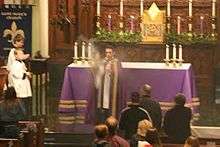

.jpg)